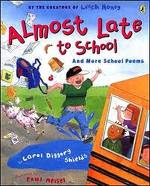
Smothers, Ethel Footman. 2003. THE HARD-TIMES JAR. Ill. By John Holyfield. New York: Farrar, Straus and Giroux. ISBN 0374328528 [Suggested Grade Levels 1-3]
SUMMARY and ANALYSIS
Being the daughter of migrant workers isn’t easy. Emma and her family moves around a lot. And when they aren’t moving around they are always working hard picking crops to make enough money to survive. Emma knows that there is barely enough money to cover the basic needs of her family of five, much less to buy a store-bought book. But Emma still dreams of owning her own store bought book, and in the mean time she decides to make her own books from scraps of paper. Emma devises a plan to be able to afford a book, but quickly realizes with sadness that her plan will not work. Emma then feels hopeless as she wonders if she will ever be able to own her own store-bought book.
Beautifully created pictures that have the appearance of canvas paintings, along with wonderfully stylistic wording will be quick to draw anyone in to this fictional tale of a migrant family. Illustrations created by John Holyfield will really make the story come alive to readers of all ages. Amazing analogies compare scarcity of money to "hen’s teeth" and describe “string beans that hung like long green fingers.” This is a fantastic book that reminds it’s readers to appreciate the blessing of the simple things. Smothers has produced an eye-opening book into a way of life with which many many readers may not be familiar.
CONNECTIONS
This book would be a great discussion starter about what people know about migrant workers as a tool in a in a social studies unit about migrant workers. This could also be an exercise in creative writing. After reading this book the children could create their own books using paper bags for paper and other remnants and write about what life would be like as migrant worker.
Use this in an English lesson and do an exercise with children picking out and discussing all the analogies they can find such as “Scarcer than hen’s teeth,” “Rusty red pennies. Thin dimes. And … a fat quarter.” And “String beans hung like long green fingers.”
RELATED BOOKS
Other stories about using the imagination to change the surroundings:
Gray, Libba Moore. MY MAMA HAD A DANCING HEART. ISBN 0531071421
Rylant, Cynthia. THE OLD WOMAN WHO NAMED THINGS. ISBN 0152021027
Other books by Smothers that could be compared to this one:
AUNTEE EDNA. ISBN 0802851541
By Kristi Mays















